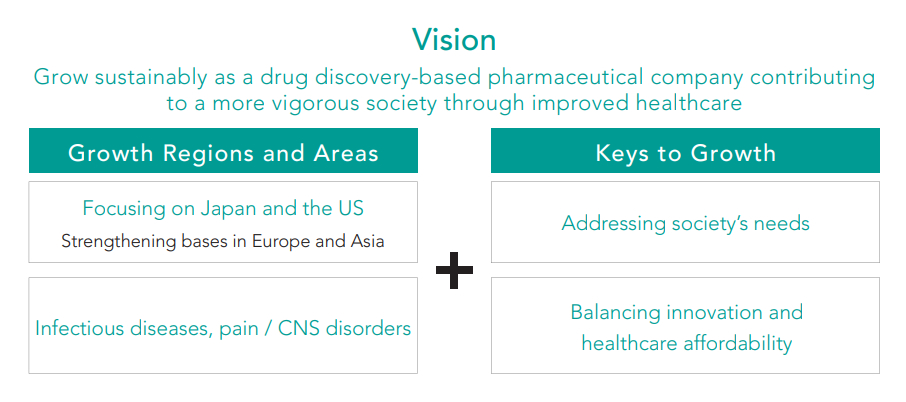Our History Museum
1878
Founding
The founder, Gisaburo Shiono, learned wholesale trade under the guidance of Kichibei, his father, who ran a drug wholesale business. On March 17, 1878—Gisaburo’s 24th birthday—he launched his own drug wholesaler, Shiono Gisaburo Shoten, in Doshomachi 3-chome 12, Osaka. This was the beginning of the present-day Shionogi & Co., Ltd.
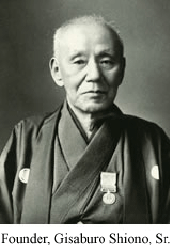
1886
Switch from Japanese and Chinese medicine to Western medicine
1909
Switch from Western medicine to new drugs: First new drug, Antacidin
After Gisaburo’s second son, Chojiro, graduated from the Pharmaceutical Department of the Faculty of Medicine and Pharmaceuticals at Tokyo Imperial University, Shionogi started conducting full-fledged pharmaceutical research. At that time, a supervising pharmacist of Shiono Gisaburo Shoten heard from a chief pediatric physician at Osaka Prefectural Medical School (now School of Medicine at Osaka University) about a prescription for an antacid agent, which had been written in a German pharmaceutical book. Chojiro started manufacturing trials of the antacid agent, and the produced marketed product successfully. This new anti-indigestion drug, Antacidin, was the first launch of its own innovative drug by Shiono Gisaburo Shoten.
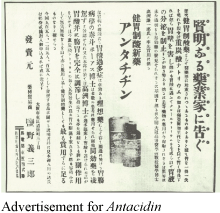
1909
Register its corporate trademark FUNDOH, symbolizing pursuit of accuracy
Reliability and trust are necessary qualities for effective management. From its founding, Shiono Gisaburo Shoten also regarded these qualities as its most valuable “capital.” The corporate logo of Shionogi is derived from “FUNDOH,” a stylized image of a balance weight historically used to dispense products. FUNDOH also symbolizes “accuracy,” “honesty” and “trust” and represents precision and commitment to quality.
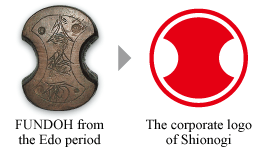
1910
Establishment of Shiono Seiyakusho: Manufacturing new drugs
After the successful launch of Antacidin, Gisaburo aimed for full-fledged development of new drug manufacturing. To that end, the pharmaceutical plant, Shiono Seiyakusho was constructed in Nishinari-gun, Osaka (now Fukushima-ku, Osaka). For the first time, Shionogi had a pharmaceutical department both in name and in reality; Shionogi had now advanced from being a drug wholesaler to becoming a research-based pharmaceutical company.
In 1910, the plant began operating with Chojiro as Director. However, at the time, imported drugs were overwhelmingly dominant in pharmaceutical business. Pharmaceutical companies in Japan struggled, forced to rely on imported drug substances. Faced with these circumstances, Chojiro looked to Shiono Seiyakusho as a foundation for future growth. To overcome the tough financial conditions, he invited Heizaburo Kondo, a doctor of pharmacology who had just returned to Japan after study in Germany, to join the operation as a consultant. Digitalis preparation, which had been introduced by Dr. Kondo and developed into a product, was launched in 1912 as the new cardiac drug Digitamin. Import of overseas drugs halted two years later with the start of World War I, but Shionogi saved many lives, not only by manufacturing and distributing the in-house Digitamin, but also by actively dealing in domestic pharmaceutical products.
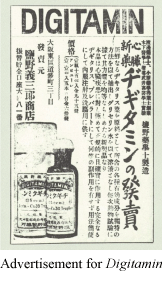
1943
Change of corporate name to Shionogi & Co., Ltd.
In 1943, the corporate name was changed to Shionogi & Co., Ltd., (Shionogi Pharmaceuticals in English) to clearly demonstrate that the business would focus on pharmaceutical activities.
1945
Recovery from devastation: To being an international-level company
Gisaburo Jr., second President of the Company, gathered the employees and spoke, “This is not the time to idle grief. From here on, the world is our partner. We have nothing, and we will not survive if we do not apply ourselves and aspire to being an international-level company.”
In truth, society was in chaos, a result of the rapid progression of runaway inflation and intensifying price increases in the postwar years. Companies were affected as well, suffering freezes on corporate deposits and cancellation of wartime compensation. Shionogi was no exception, being in bad financial circumstances and falling into the worst crisis since its founding.
Gisaburo Jr. said, “The only way to eliminate the deficit is for everyone—at every level and every post—to raise their skill levels and cut costs, and to concentrate their resources and efforts. All employees can feel the pressure of this crisis and everyone must combine forces to overcome it head on.” In 1948, the Company developed a plan outlining three main objectives to overcome crisis (1. Improvement of quality in every skill, 2. Identification of goals and sufficient progress review, and 3. Keeping the workplace clean), and began efforts to improve management. This was not a temporary measure to increase production in the short term, but a deliberate first step on the road to business streamlining, which would improve productivity for the future growth.
1950
Launch of analgesic Sedes
Sedes has offered treatment of pain for more than half a century. As suggested by the drug’s catchphrase, “Take Sedes immediately for your pain,” Shionogi contributes to improvement of people's quality of life by offering a wide range of products in response to their needs.
1953
Launch of multivitamin supplement Popon-S
Thanks to the diffusion of health information, vitamin compounds previously used as therapeutic drugs began to see frequent use as health promotion agents, offering benefits such as recovery from fatigue and improvement of physical health. At the time, such vitamin compounds were one of Shionogi’s most important products, in terms of both sales and profit. Shionogi launched Popon-S, a multivitamin supplement in 1953. The current Popon brand products have undergone several improvements since that time.
The name “Popon-S” combines “Popon” a lively onomatopoeia meaning “extraordinary vigorous vitality and eagerness,” and “S” for “Shionogi.”
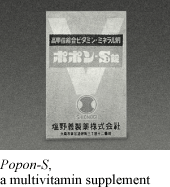
1957
Establishment of the Company Policy: “Shionogi strives constantly to supply the best possible medicine to protect the health and wellbeing of the patients we serve”
The Company Policy of Shionogi was established in 1957, a compilation of the management attitudes the Company nurtured throughout its history. The Company Policy, which sets forth an eternal goal to strive for, enables us to move forward without losing our basic direction as a pharmaceutical company: “to serve people’s health.”
1958
Establishment of a modern product detailing system
Since the establishment of the new system, our Sales Department staff has diligently embraced what we call the “detail and trace” approach. They accurately explain our drugs’ efficacy and adverse reactions, and make appropriate inquiries as to the level of medical benefit they show. The declaration clearly represented our collected efforts to adhere to the philosophy “Put morality first, then profits will follow.”
1959
Shionogi, specialists in antibiotics: Launch of Sinomin, the first single-handedly developed product
Sinomin, the first sulfonamide antibiotic drug discovered and developed by Shionogi, was launched in 1959. Two years later, Sinomin began to be marketed all over the world, based on its highly appreciated, superior efficacy. In consideration for the scope of the potential global sales growth of antibiotics-related products, Shionogi constructed a plant for manufacturing antibiotics. Additionally, Shionogi had developed a close relationship with US-based Eli Lilly and Company, one of the overseas pharmaceutical partners that Shionogi had been importing drugs. In 1952, Shionogi obtained exclusive manufacturing and marketing right for Ilotycin, a new antibiotic discovered by Eli Lilly and Company. Subsequently, cephalosporin antibiotics were successively introduced into the market, all of which greatly increased Shionogi’s sales: Keflin in 1966, Keflodin in 1967, and Keflex in 1979.
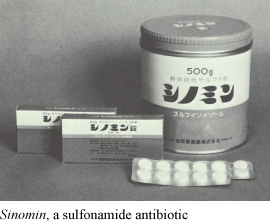
1982
Shionogi, specialists in antibiotics: Launch of Shiomarin discovered in-house
Partnership with Eli Lilly and Company significantly benefitted Shionogi’s research and manufacturing capabilities in addition to its sales. In 1961, a basic research facility, Shionogi Research Laboratories (now integrated into Shionogi Pharmaceutical Research Center) was established to conduct antibiotics research. In 1982, this research resulted in the successful discovery and launch of an in-house product: Shiomarin, the world's first oxacephem antibiotic. Flumarin and Flomox were then launched in 1988 and 1997, respectively, earning Shionogi the title “Shionogi, specialists in antibiotics,” and the high level of its fundamental research was highly praised in academic world.
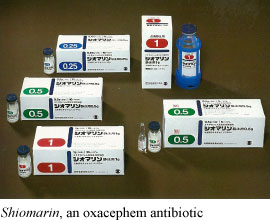
1983
Construction of Kanegasaki Plant
Based on a long-term plan for future expansion of pharmaceutical plant facilities, Kanegasaki Plant, one of Shionogi’s key plants, was constructed on a large plant site secured in Kanegasaki-cho, Isawa-gun, Iwate.
This plant, which was equipped with manufacturing technologies and a quality control system inspected and approved by overseas regulatory authorities such as the U.S. Food and Drug Administration (FDA), and manufactures in-house anti-infective and anti-pain agents. Along with Settsu Plant in Osaka and Kuise Site in Hyogo, it has been manufacturing high-quality products with commitments to safety, quality, supply, cost, and environment.
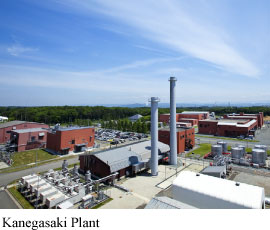
1998
Establishment of the Shionogi Charter of Conduct
Upon the charter’s establishment, Yoshihiko Shiono, President, also began efforts to reform the organization and personnel system so that Shionogi could adapt to various changes in the environment, ensuring that the Company would survive and thrive in the 21st century.
April 2000 to March 2005
The 1st Medium-Term Business Plan: Laying the foundation
First, Shionogi divested business in areas such as agricultural chemicals, veterinary drugs, drug wholesale, etc. to other companies, allowing us to focus our business exclusively on pharmaceutical products. Then, in 2001, an affiliated development company was established in the US, intended to concentrate on priority research fields and to speed up development. Furthermore, established joint venture with UK-based GlaxoSmithKline, and collaborative development of new drugs was started.
These efforts resulted in an improved management culture and steady progress in development of pipelines (candidate compounds under development). An anti-obesity drug candidate and an anti-HIV infection drug candidate began to increase their presence as future growth drivers. Finally, the hyperlipidemia treatment Crestor, which was licensed out to UK-based AstraZeneca, was launched in the US and in over 100 other countries since 2003, providing Shionogi with considerable royalty revenue.
April 2005 to March 2010
The 2nd Medium-Term Business Plan: Accelerating toward significant strides
In the 2nd Medium-Term Business Plan, implemented in 2005, royalty revenue gained from Crestor was invested it intensively into research and development of three priority areas: infectious diseases, pain and metabolic syndrome.
At the same time, Isao Teshirogi, President and CEO, who succeeded Motozo Shiono, ex-President in April 2008, acquired US-based Sciele Pharma, Inc. in order to streamline overseas sales foothold for products discovered in-house. Consequently, Shionogi was able to build a self-sales network in the US, the largest pharmaceutical market in the world.
In the domestic market, strategic products such as Crestor were launched one after another, and Shionogi focused on new products and shifted from acute disease treatment drugs such as antibiotics to drugs treating chronic diseases.
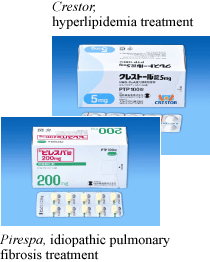
April 2010 to March 2014
The 3rd Medium-Term Business Plan: SONG for Real Growth
The 3rd Medium-Term Business Plan was announced as a strategy to overcome the so-called “Crestor Cliff,” an expected drop in royalty revenue after 2016 upon expiration of Crestor patents, and to facilitate further growth.
In 2011, Shionogi Pharmaceutical Research Center 4 (SPRC4), a new, cutting-edge, research facility, was constructed at a site in Toyonaka, Osaka, which integrated dispersed functions of drug discovery research into SPRC consisted of the existing three research facilities and a newly constructed one.
At the same time, in the US business, a reform of the business model and structure of Sciele Pharma, Inc., was moved up due to suspension of development of anti-obesity drug candidate expected to be marketed in the US. The Company restarted as Shionogi Inc. with new management in 2011 and in 2013, launched Osphena, the first global new chemical entity filed, approved and introduced by Shionogi Inc.
Shionogi acquired C&O Pharmaceutical Technology (Holdings) Limited, a Chinese pharmaceutical company in 2011, and the affiliated development company Shionogi Limited was established in London in 2012. All these measures go straight toward the global embodiment of the Company Policy.
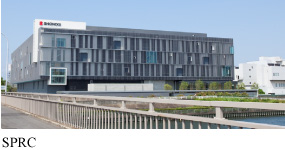
April 2014 and beyond
The New Medium-Term Business Plan:
Grow as a drug discovery–based pharmaceutical company
In April 2014, the 3rd Medium-Term Business Plan was brought to an end one year early, and we formulated its New Medium-Term Business Plan “Shionogi Growth Strategy 2020 (SGS2020).” This decision, among others (including the establishment of new business scheme with ViiV Healthcare for the HIV integrase inhibitor franchise products, announced in October 2012, and modification of the Crestor royalty structure with AstraZeneca, announced in December 2013) was made in an effort to adapt to rapid changes in the external business environment, which required us to revise the business targets set by the 3rd Medium-Term Business Plans.
In the New Medium-Term Business Plan, our vision includes the goal to “grow as a drug discovery–based pharmaceutical company.” The plan sets return on equity (ROE) as one of the management indicators, specifies business targets to be achieved in the next three years, and intends to update results and progress toward overcoming the remaining challenges to achieving its financial targets for FY2020 each year on a rolling basis. By undertaking these efforts, we are determined to conduct business in a way that is flexible enough to adapt to rapid changes in the external business environment, as well as to propel further growth by focusing on drug discovery and research to create innovative medicines.
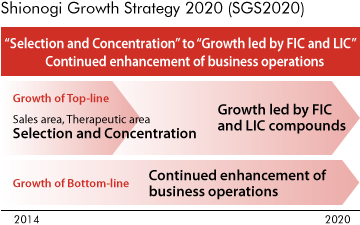
May 2016 and beyond
Updated Medium-Term Business Plan:
Grow as a drug discovery–based pharmaceutical company.
We are now in the final stages of the plan. Based on a shared sense of urgency, every employee is working together to achieve the plan’s targets and laying the foundations for the next phase of growth from 2020, which will mean overcoming the “dolutegravir cliff” in about a decade.
Basic Strategy in Updated SGS2020
